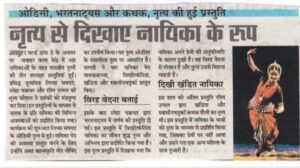To celebrate World Dance Day, Jawahar Kala Kendra in Jaipur organised an evening of Indian classical dance on April 29, 2018, inviting three dancers representing the Kathak, Odissi and Bharatanatyam styles of dance to conceptualise an evening showcasing the various nayikas or heroines based on Natyashastra. Rashmi Uppal, Lipsa Sathpaty and I presented traditional compositions in Kathak, Odissi and Bharatanatyam respectively for this evening titled ‘Ashta Naayika’.

I performed a varnam depicting the virahotkanthita nayika in the Bharatanatyam style. This nayika is distressed at her lover’s absence and suffers the pangs of separation, yearning for reunion. Due to the non-arrival of her lover, she openly demonstrates her distress, exhaustion and discontent. She is anxious, disheartened and restless, but, she does not doubt her lover and usually thinks of various reasons because of which he may have been unduly delayed.

The Varnam is the centre piece of Bharatanatyam that brings alive the various aspects of the dance form: abhinaya, raga-bhava, tala and sanchari-improvisation. Varnam means different shades of colour and is the most elaborate presentation that showcases the best in both nritta or pure dance and abhinaya or narrative interpretation. The format of varnam provides a platform to explore layers of emotions, a variety of situations and vivid images and it presents an array of challenging dance patterns. The varnam that I presented was in Ragam Poorvi Kalyani set to Adi talam (a cycle of eight beats) penned and musically composed by the legendary Bharatanatyam Guru Shri. K.N. Dandayudhapani Pillai and taught to me by my guru Smt. Geeta Chandran. Essaying Bhakti-Shringar, the virahotkanthita nayika in the Varnam beseeches her sakhi, and pleads with her to fetch her lord Kumaraswamy (Kartikeya) to her.
The performance received great media coverage in the local news papers.




